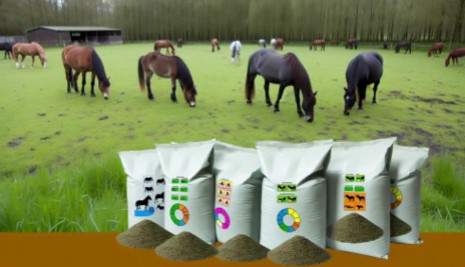Imagine standing in front of a shelf lined with various horse ration balancers, each promising optimal health and performance. You know your horse’s dietary needs are unique, influenced by factors like age, workload, and health status. Choosing the right balancer requires a careful assessment of nutrient profiles, ensuring they match your horse’s requirements. You’ll need to scrutinize labels for key nutrients such as vitamins, minerals, and protein levels while considering serving sizes. But how do you make sense of all this information and ensure you’re making the best choice for your horse’s well-being?
Understanding Ration Balancers
Ration balancers are specialized feed products designed to provide horses with essential nutrients without the excess calories found in traditional grain-based feeds. They’re formulated to ensure your horse gets vital vitamins, minerals, and proteins from concentrated nutrient sources.
Unlike complete feeds, ration balancers fill in nutritional gaps without adding unwanted calories, making them ideal for easy keepers, overweight horses, or those on forage-based diets.
When incorporating a ration balancer into your horse’s feeding schedule, it’s crucial to consider the specific nutrient sources included. Look for high-quality ingredients like soybean meal, alfalfa, and flaxseed, which supply essential amino acids and fatty acids.
These nutrient-dense components are often balanced with vitamins and minerals to support overall health, including bone strength, coat condition, and metabolic function.
Feeding schedules should be tailored to your horse’s individual needs. Typically, ration balancers are fed in small amounts, usually between one to two pounds per day, depending on the horse’s weight, activity level, and forage intake.
Consistent daily feeding helps maintain stable nutrient levels, promoting optimal health and performance. Always consult with a veterinarian or equine nutritionist to fine-tune your horse’s diet.
Assessing Your Horse’s Diet
To ensure your horse’s nutritional needs are met, start by thoroughly assessing their current diet. Begin by evaluating nutrition through a detailed review of all feed components.
Collect information on the types and quantities of forage, grains, and supplements your horse consumes daily. Pay close attention to forage quality, as it forms the cornerstone of their diet. Analyze the hay or pasture for nutrient content, focusing on protein, fiber, and energy levels.
Next, scrutinize any grain or concentrate feeds, noting their nutritional profiles, including macronutrient and micronutrient content. Ensure you’re aware of the specific needs of your horse based on their age, workload, and health status. For example, a young, growing horse will have different requirements compared to an older, sedentary one.
Record this data meticulously, and compare it against recommended dietary guidelines. Look for any deficiencies or excesses that could necessitate dietary adjustments. Consulting with a veterinarian or equine nutritionist can provide insights into areas needing improvement.
Key Nutrients to Look For
When selecting the right horse ration balancer, it’s crucial to focus on key nutrients that support overall health and performance.
First, ensure the balancer includes essential vitamins like A, D, and E, which are vital for immune function, vision, and muscle health. Vitamin A aids in cellular repair and growth, while Vitamin D is necessary for calcium absorption, essential for strong bones. Vitamin E acts as an antioxidant, protecting cells from oxidative damage.
Next, examine the mineral content. Calcium and phosphorus should be in a balanced ratio, typically 1.5:1, to promote optimal bone development. Magnesium is another critical mineral for muscle function and preventing cramps. Trace minerals like zinc, copper, and selenium are also indispensable. Zinc supports skin integrity and immune function, copper is crucial for iron metabolism and connective tissue formation, and selenium works with Vitamin E to protect against cell damage.
Lastly, don’t overlook amino acids like lysine and methionine, which are building blocks for protein synthesis and muscle repair. By carefully selecting a ration balancer rich in these key nutrients, you’ll ensure your horse maintains peak health and performance.
Types of Ration Balancers
One important aspect to consider is the variety of ration balancers available on the market. These balancer options can be broadly categorized based on their nutrient profiles and the specific needs they address.
You’ll find balancers formulated for different life stages, such as those for growing foals, mature horses, and senior equines. Each type is designed to complement the forage your horse consumes, ensuring a balanced intake of essential vitamins and minerals.
For example, balancers for young horses typically contain higher levels of protein and calcium to support rapid growth and bone development. On the other hand, options for mature horses focus on maintaining optimal health and often include antioxidants like Vitamin E and Selenium to support immune function.
There are also specialty balancers aimed at horses with specific health conditions. For instance, low-starch balancers are ideal for horses prone to metabolic issues like insulin resistance. These are formulated to provide necessary nutrients without exacerbating blood sugar levels.
When choosing a ration balancer, it’s crucial to align the nutrient profile with your horse’s unique requirements. By carefully selecting from these balancer options, you can ensure that your horse receives a well-rounded diet that supports overall health and performance.
Reading Labels Correctly
Understanding the fine print on ration balancer labels is crucial for making informed choices for your horse’s diet. Start by examining the nutrient analysis section, which lists the specific vitamins, minerals, and protein levels. Pay close attention to key nutrients like calcium, phosphorus, and trace minerals, as these are essential for maintaining your horse’s health. The nutrient analysis will oftentimes give you a percentage breakdown, so you can compare different products effectively.
Next, you’ll want to focus on the serving size indicated on the label. This detail is pivotal because the nutrient concentrations are based on a specific amount of the balancer. Misinterpreting the serving size can lead to either underfeeding or overfeeding, both of which can cause nutritional imbalances.
For instance, if the recommended serving size is 100 grams per day, make sure you’re measuring accurately to provide the correct nutrient intake.
Also, consider whether the balancer meets your horse’s particular needs, such as age, activity level, or any existing health conditions. By carefully reading and interpreting these labels, you ensure that your horse receives a balanced diet tailored specifically to its requirements.
Consulting With a Veterinarian
It’s essential to consult with a veterinarian before making any changes to your horse’s diet, including the introduction of a ration balancer. A veterinarian can provide expert veterinary recommendations tailored to your horse’s specific needs, ensuring optimal health and performance.
Scientific studies have shown that individualized dietary plans lead to better nutrient absorption and overall well-being.
One of the primary benefits of consulting with a veterinarian is their ability to determine the proper dosage of the ration balancer. Over or under-supplementation can lead to imbalances and health issues such as metabolic disorders or deficiencies. Veterinarians use evidence-based guidelines and diagnostic tools to calculate precise nutrient requirements.
Monitoring your horse’s response to dietary changes is another crucial aspect managed by your veterinarian. Regular check-ups and blood tests can help track the effectiveness of the ration balancer, allowing for adjustments as needed. This proactive approach can prevent potential problems and ensure your horse is receiving the maximum benefit from their diet.
Conclusion
Choosing the right horse ration balancer is like finding the perfect puzzle piece; it completes your horse’s dietary needs seamlessly. By understanding ration balancers, assessing your horse’s diet, and focusing on key nutrients, you’ll ensure they receive essential vitamins and minerals. Always read labels carefully and consult with a veterinarian to confirm your choice. This evidence-based approach promotes optimal health and performance, ensuring your horse thrives while avoiding unnecessary calories.





